As an Amazon Associate I earn from qualifying purchases.
I can’t remember the first time I ate a clam. But I do know it was far earlier than my first oyster, or scallop, or mussel. And it was likely this Maine clam chowder recipe that’s been in my family for more than a century.
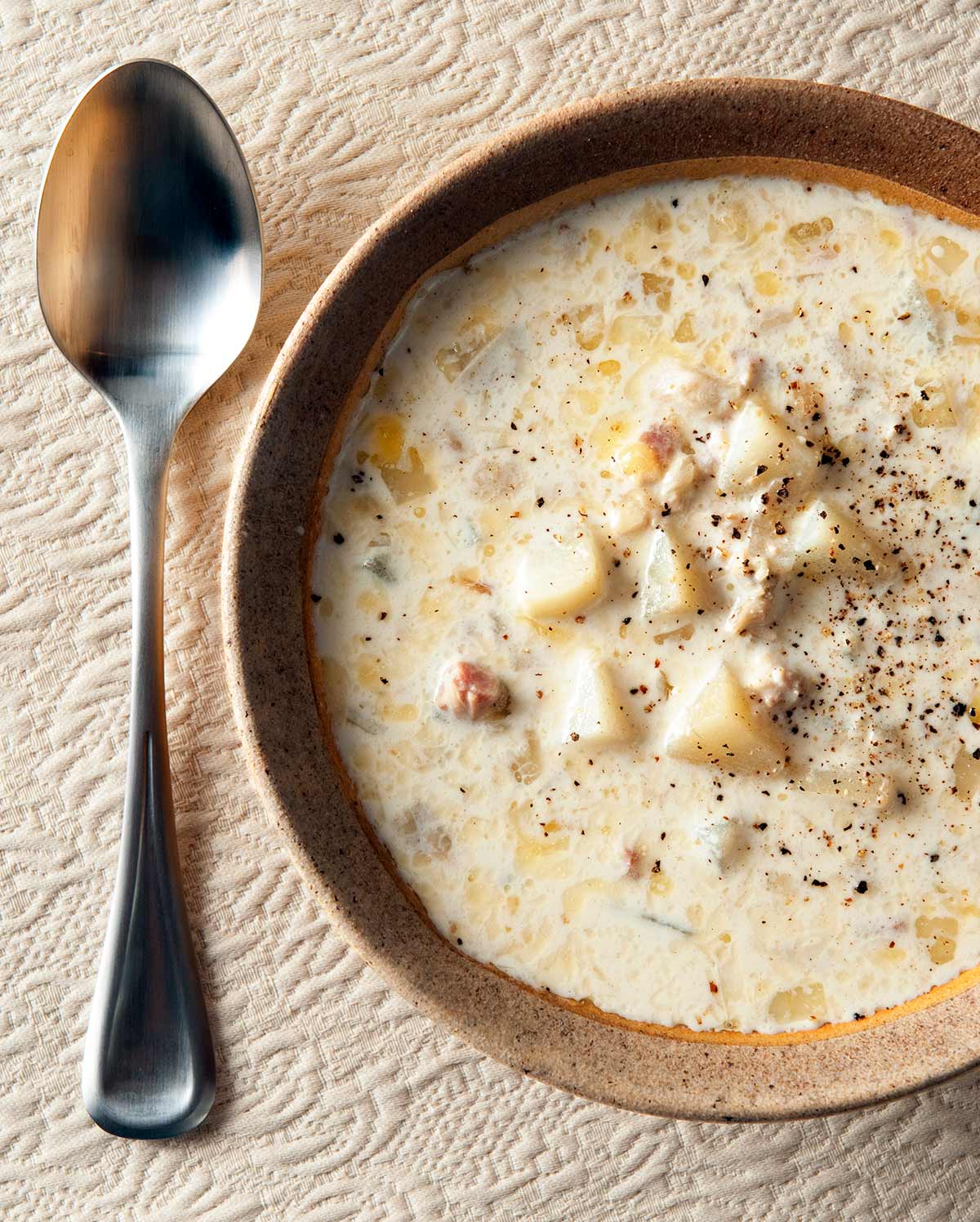
Clams are in my family’s DNA. My mom, after all, is a native of Ipswich, Massachusetts. And if there is a place more clam-centric than Ipswich, I can’t think of it; there is even a clam nicknamed the “Ipswich clam.” We know it as the steamer.
To me, clams mean vacation. Summertime. Happiness. I’ve written about my fond memories of digging hard-shell clams on Block Island both in this space and in my book, and even today, 3,000 miles from New England, clamming in the mud flats of California brings joy to my heart the way nothing else really does.
I owe all of this to my mom. It was she who taught me how to dig and eat clams. So imagine my surprise when it finally dawned on me, sometime in my teenage years, that mom really doesn’t care for clams all that much.
Don’t get me wrong: She led our clamming expeditions on Block Island, her version of stuffed clams is one of my favorites, and no one else’s New England clam chowder can ever compare to hers. I only learned it was a Maine clam chowder later in life. More on that in a bit.
For mom, clams and clamming bring back bittersweet memories of her childhood on coastal New England. It was just after World War II, and while times weren’t so hard as in the Depression, the beauty of the shoreline was mixed with some hard, smelly work.
Every Friday during those summers it was up to mom and my Uncle David to gather steamer clams for dinner and quahogs for chowder. I asked her to tell me about it a few years ago, and this is her story:
The steamer or ‘piss clams’ were dug at low tide and we walked to the flat from our cottage in Ipswich carrying our large clam bucket, a pitchfork and a small tin can for the sea worms. [Mom sold them as bait.]
The steamers were plentiful then and the water wasn’t polluted so it was safe to eat the clams that we dug. The clams were easy to find, as when the tide goes out the clams bury themselves deep into the mud and leave a small round air hole, which is a dead giveaway that the clam is there. For some reason the clams like to all live together in the same area, so once we started to dig we found plenty of them.
We tried hard not to pierce their soft shells with the pitchfork and mostly were successful. We did this by not digging quite as deep as where the clams lay and then used our hands to finish the job. As we dug away the mud, we sometimes got cuts on our hands from the sharp empty clamshells that were sticking up at odd angles. No manicure in those days!
But what a delight it was to reach into the mud and come up with a juicy, spitting (they spit out a long stream of salt water when picked up to try to frighten you away), healthy steamer clam to plunk into the bucket!
…After we had a bucket full of steamer clams, we got our rowboat and went to the enormous sand bar off the south end of Plum Island, which juts out into Ipswich Bay. We would pull our boat up onto the bar and drop the anchor. If the tide turned and started coming in we would keep careful watch and keep moving the boat higher up onto the bar.
The process to find the giant sea clams (what we locally called quahogs) is to wade waist deep in the water out onto the bar and start to wiggle your toes in the lovely sandy bottom. When your heel, foot or toe hit something very hard you knew you had found your first quahog! Then you had to dive down under the water and using two hands dislodge the sea clam from its hold on the sand. This is easier said than done. The quahog has an enormous “foot” which it proceeds to stick out into the sand to help anchor it in place. So it is a tug of war to get the thing up and out of the sand.
Because we were waist deep in water we had to be up-ended very much like you see the ducks and swans do when they are looking for food. Fortunately, it only takes two or three of these large clams to make a very tasty chowder.
Sounds pretty fun to me, but once she returned home, I got a sense of why mom isn’t all that keen on clams to this day. Clams, if you’ve ever cleaned one, are pretty gnarly. And remember she was about 12 or 13 years old at the time.
…My job was to make the chowder. This meant I had to clean those enormous, nasty quahogs. To this day I really don’t enjoy eating clams of any kind. The quahogs had huge, nasty bellies which I had to separate and throw away, and they had a 5-6 inch long translucent, round tube in them that was slippery and hard. I don’t know how the clam used it [The tube is called the crystalline style; it’s part of the clam’s digestive system.], but it was yucky! That too had to be removed and thrown out.
That left the luscious, pink-colored, firm, meaty foot (the part that the quahog used to try to anchor itself in the sand so I couldn’t pull it up) and two large, round, white muscle hinges. These I was happy to grind up for the chowder.
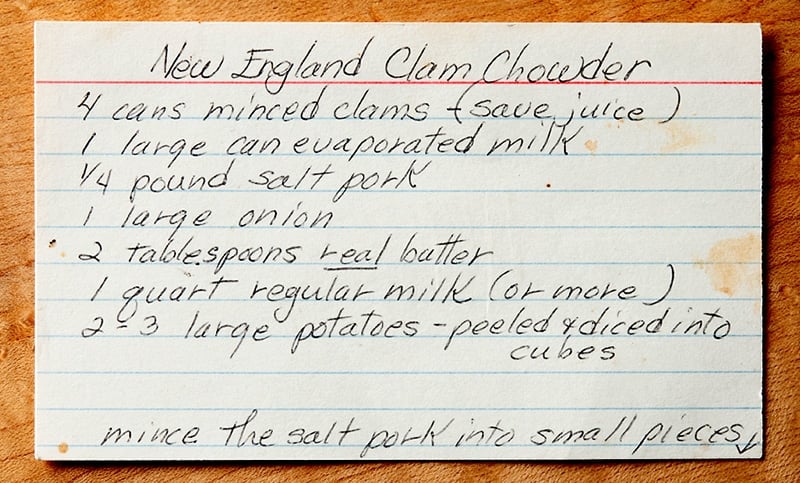
I’m pretty durable, but even I get skeeved out a bit by that freaky translucent tube; when you clean a clam, it seems to be alive — almost rocketing out of the clam belly when you cut it open. And, as they say, it was a brave person who first ate a clam. While not quite so snot-like as a raw oyster, a raw clam doesn’t scream out yummy! Even though it is.
Nonetheless, I grew up eating clams. Which means mom made them. And all her clam recipes are fantastic. Especially her Maine clam chowder.

For the first 30-odd years of my life, I just thought mom’s chowder was unique to our family. It is a white chowder like most New England versions, but unlike the chowders in much of Massachusetts, mom’s is soupy and brothy, not thick and creamy.
It was only when I delved more seriously into food that I realized this was a recognized variety of chowder; it’s a Maine clam chowder. I asked mom about this, and she reminded me that her mother grew up in Wiscasset, Maine. Mystery solved.
Looking back on all this, I am struck by how important it must have been for mom to raise us all as bona fide clam lovers, even though it was not something she herself still liked to eat. It was both an act of regional pride (Yankees eat clams. Period.) and, more importantly, an act of love.
I am thankful for that, and for all the other acts of love mom has shown me over the years, both large and small. Every time I eat this particular New England clam chowder, I think of her. I love you, mom. Happy Mother’s Day. I hope I did your chowder proud.
Maine Clam Chowder
Ingredients
- 2 tablespoons butter
- 1/4 pound salt pork or bacon, minced
- 1 large onion, about 1 1/2 to 2 cups, chopped
- 2 pounds potatoes, about 3 to 4 cups, peeled and diced
- 1 quart clam juice
- 1 pound chopped clams, about 1 pint
- A 12-ounce can of evaporated milk (do not use lowfat milk)
- 3 cups whole milk
- Black pepper to taste
Instructions
- In a large soup pot, heat the butter over medium heat and add the diced salt pork and onions. Fry this slowly until the the onions are soft and translucent. Do not brown the onions.
- Mix in the potatoes and the clam juice and add enough water to just barely cover the potatoes. Bring this to a simmer and cook until the potatoes are tender, about 15 minutes.
- When the potatoes are just about tender -- not completely cooked -- add the chopped clams and turn off the heat. Let this cool for at least 30 minutes. You can make this chowder base up to a day ahead if you'd like.
- Once the chowder base is pretty cool (below 100°F), add the milk and evaporated milk and turn the heat on low. Gently bring the chowder up to eating temperature, and be very careful not to let it simmer. Add some freshly ground black pepper to taste and serve hot.
Notes
- A word on the clams. I am using gaper (horseneck) clams from California because that's what I have. A real Maine chowder uses quahogs, which are the dominant clam in markets on the East Coast. Canned clams are OK, too, although not as good.
- Eat this chowder with Yankee cornbread -- mom calls it johnnycake -- and a salad.
- Oh, and I'll leave this here as a final note: If you are scared of the possibility of your chowder curdling, skip the 3 cups of whole milk, add more clam broth or fish stock to replace it, and pour in at least a half pint of heavy cream. That's foolproof.
Nutrition
Nutrition information is automatically calculated, so should only be used as an approximation.
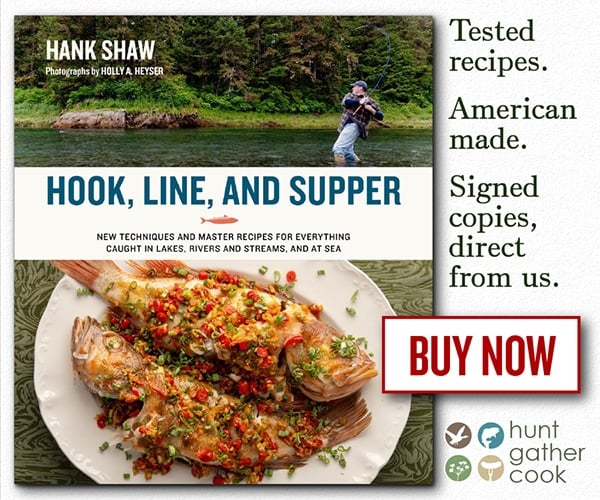
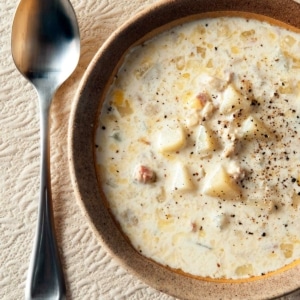


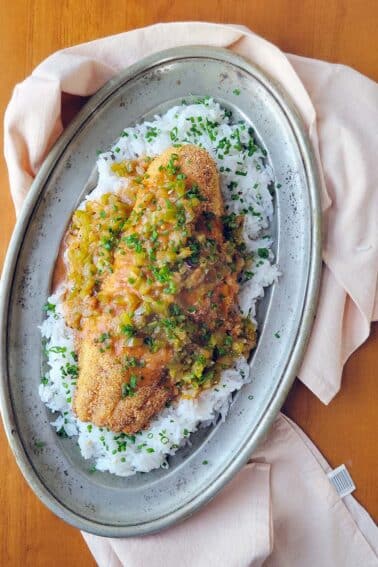
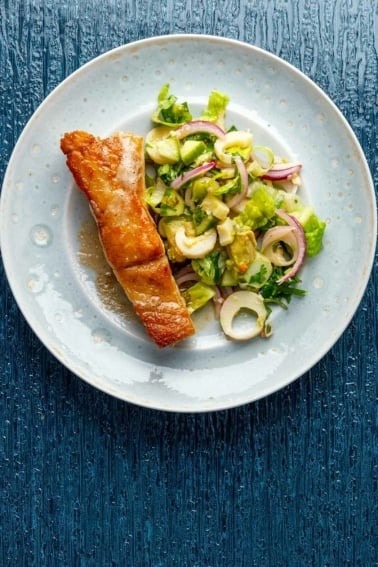
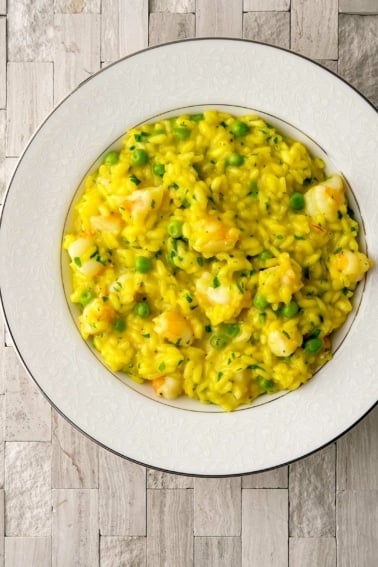
This is the real thing. No flour, no herbs, no bacon. When someone talks about chowder that you can stand up your spoon in it, I try to explain that’s wrong. And while I have a prejudice against bacon in clam chowder, it saved our butts one day! The Country Club where I worked as a cook was hosting a lobster and clambake for 200. Chowder was on the menu. Unfortunately, the very large pot scorched on the bottom and the chowder had a burnt taste. We quickly cooked off a bunch of bacon under the broiler and crumbled it into the chowder. We got rave reviews!
I love seeing that you’ve posted an authentic NE clam chowder recipe! This is exactly the way my mom taught me, and it’s the best!! The only way it can be better is if you’ve made steamers and saved the broth to use for the chowder. 🙂
I swear this is the same recipe I grew up on. I live in Boston now and I’ve never found a clam chowder like my mother’s. I was looking for a recipe similar to hers when I stumbled upon this one. funny thing is I grew up in Brunswick, right next door to Wiscasset.
I sure miss the New England area when I think of seafood. Living along the coast of Texas we have our share of great seafood but nothing like the Boston area. This is actually the type of chowder I enjoyed the most, although I didn’t realize it was a regional thing. Thanks, I’m going to make some this week.
Great Mom story Hank, my Mom bought me Buck, Buck, Moose as a Xmas present for 2015, and did so on the pre order to get me a signed copy. Unfortunately she passed away in June of ‘18 before it shipped. My brother & sister bought me a copy after they realized I didn’t get it because her banking & credit card was closed out. I learned much about cooking from her and someday I’m gonna ship my copy to Hank and have him sign it in my Mom’s memory. PS- the next time I make clam chowder it’ll be Mrs. Shaw’s recipe!
Laughed at the clam cleaning, and loved the recipe from your mom..yes we Yanks love our clams ( smiling ) ..nothing like raw , or steamed and clam chowder is ?well ,my favorite of course..thanks for your. Narrative,And course for sharing your moms recipe..
Sounds good, I want to try it. Just one question, after you clean the clams, do you cook them or put them in the chowder when they’re raw?
Bryan: They go in the chowder raw.
Thank you for this recipe! I was looking for a thinner, authentic recipe. Hate those gloppy thick chowders. In fact, I made it even more “brothy” by using 5 cups of clam juice (instead of 4) and decreasing milk to 2 cups. Also, to get the consistency I wanted, I heated the evaporated milk and whole milk separately and added it to the potato/clam/clam juice mixture until I achieved the thickness I wanted. I didn’t end up using all the milk because I think I used fewer potatoes and clams than I should have. All in all an amazing recipe that we all loved!
Hank, Thanks for the memories!
When I was in high school in northern Vermont, my folks bought a used 18 foot travel trailer that we christened on a trip to Nova Scotia (we circumnavigated the whole province). On our way up the Maine Coast we stopped for the night at a campground on Sipp Bay in Perry. The owner came out with buckets and clam forks a short while after we had set up and told us if we wanted to, the clams on the west side of the point were plentiful.
Dad and I went out and dug up a couple of buckets full. Mom steamed them and some lobsters we had gotten from a truck on the side of the road.
Best shore dinner ever and one of my happiest food memories…
I cannot wait to use this on Christmas Eve. It is the same recipe of my Grandmother, but I did not understand why she says “to ripen it” . The explanations are great. I am raising my kids in Alaska but want them to have some Maine traditions. Thanks!
Can you thicken this with something? As a Mainer I love this simple recipe, but, I prefer a creamier chowder…
Jill: This is my recipe. If you want a creamier recipe, use another. Sorry, but I feel strongly about it — this is my Mom’s recipe and I don’t change it.
I am going to try this recipe my question is can you freeze the clam chowder once it’s made
Marion: Sorta. You can freeze it up to the point of adding milk or cream. Freeze the base, reheat, then add fresh cream.
This sounds very good! I’ll give it a try! Thanks!
We always used whole clams. We use to be able to get them at Blue Hill. This recipe is as close to what I grew up with as any. You cal also substitute cod, haddok or corn for the clams for great fish or corn chowder.
Great recipe. I grew up in Nova Scotia and this is how my mom makes chowder too, except since clams are not harvested in the area in which I grew up she makes basically this same chowder with lobster, haddock and sometimes scallops. This with biscuits was our traditional Christmas eve meal. I thought this was just how all chowder was until I grew up and tasted chowders which were made with cream or others made without dairy. I know more about different types of chowder now but this is still the only type I like.
Looking for a base recipe for the Maine clam chowders I remember as a kid, I was delighted to hear mention of Wiscasset. My dad’s family has long lived there, and there were many, many visits with very fond memories of seafood (especially the brothy chowders, and the warm lobster rolls [from Red’s!]).
Where in the world do I find clam beds?! Alas, would be awesome. And when are you publishing, uhh, “fish fish urchin” or some Cleverly titled seafood book? Hehe. I love hitting the coast for some good seafood, though. Moss landing up to Crescent city. Glorious.
P S – You will need a fishing license to go after them
You can find Washington and the occasional gooeyduck clams on the flats of Bodega Lagoon in Sonoma County as well as Lawson Landing; also Bolinas Lagoon
Looks a lot like my Cape Codder father’s recipe. His calls for cream or half and half instead of evaporated milk. I love the simple brothy style of your mother’s recipe.. I love your stories! I was doing research for an article and recipe I’m working on for my blog, Savorbang. I wondered if I could forage for clams here on a Sonoma county beach. Thank you for the guidance. I have a “dolled up” California style clam “bisque” that is delicious but I wouldn’t dare call it clam chowder around my pa.
I live in Maine and love a thin, brothy clam chowder. I will not eat a thick and creamy chowder.
This recipe looks quite similar to mine. Thanks for posting.